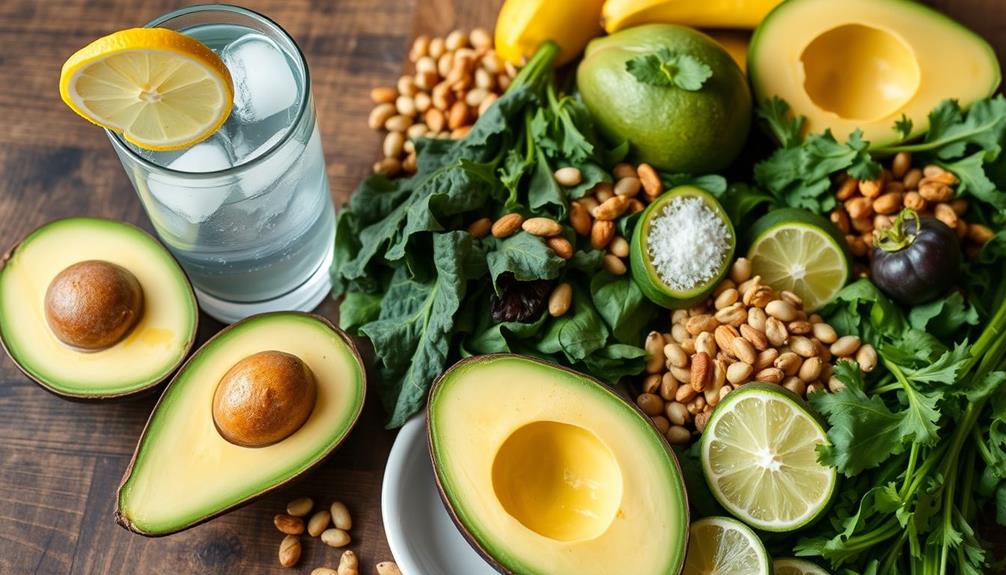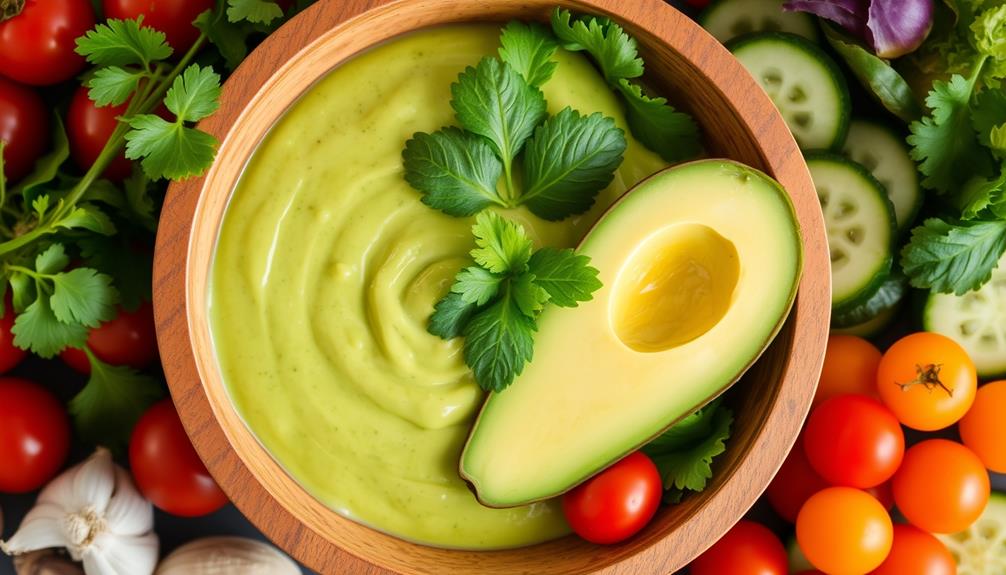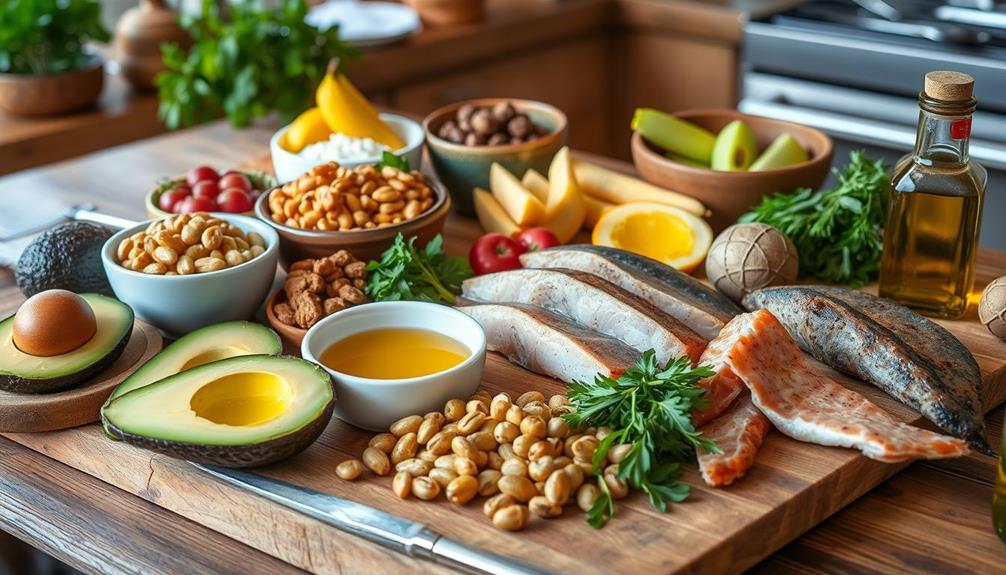To get enough electrolytes on a keto diet, focus on increasing your intake of sodium, potassium, magnesium, and calcium. Add salt to your meals and include bone broth for sodium. Load up on potassium-rich foods like avocados and leafy greens. Snack on nuts and dark chocolate for magnesium, and consider dairy for calcium. Staying hydrated is essential, so aim for 2-3 liters of water daily, and think about electrolyte supplements for extra support. By monitoring your intake, you can avoid deficiencies and feel better. Discover more tips on managing your electrolyte balance efficiently.
Key Takeaways
- Increase sodium intake by adding salt to food and consuming bone broth to meet daily needs of 2,000-4,000 mg.
- Incorporate potassium-rich foods like avocados, spinach, and leafy greens to achieve 3,000-4,700 mg daily.
- Boost magnesium levels through nuts, seeds, and dark chocolate for approximately 400 mg needed each day.
- Stay hydrated with 2-3 liters of water daily and consider electrolyte-infused drinks for added support.
- Regularly monitor electrolyte levels using dietary tracking apps to prevent deficiencies and maintain overall health.
Understanding Electrolytes
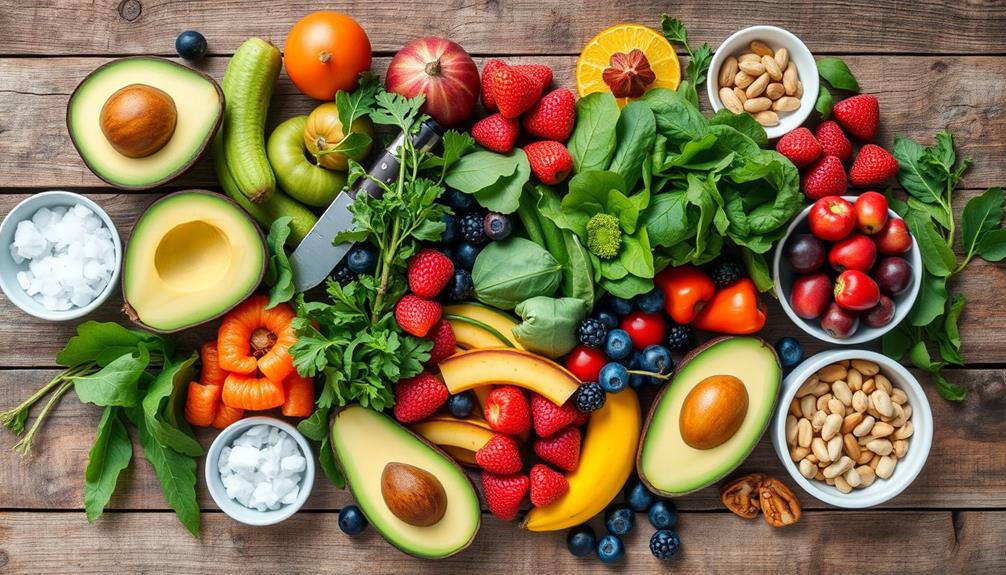
Electrolytes are essential for your body's health, playing key roles in nerve signaling, muscle contraction, and fluid balance. These charged minerals—including sodium, potassium, and magnesium—are critical for maintaining your overall well-being, especially when following a keto diet.
On a low-carb diet, your body often experiences changes in your electrolyte levels, which can be exacerbated by the impact of diet choices and the potential for nutrient deficiencies. Reduced sodium intake combined with increased losses of potassium and magnesium can lead to potential deficiencies.
When you start the keto diet, you might experience symptoms of keto, often referred to as "keto flu," which can include headaches, fatigue, muscle cramps, and heart palpitations. These symptoms are often the result of an electrolyte imbalance.
That's why it's important to monitor your daily intake of these key electrolytes. Adequate sodium helps regulate fluid balance and supports nerve function, while potassium and magnesium play significant roles in muscle function and energy production.
To prevent complications, make sure you're getting enough electrolytes through your diet. Incorporate foods rich in these minerals, and consider supplements if necessary.
Electrolyte Needs on Keto
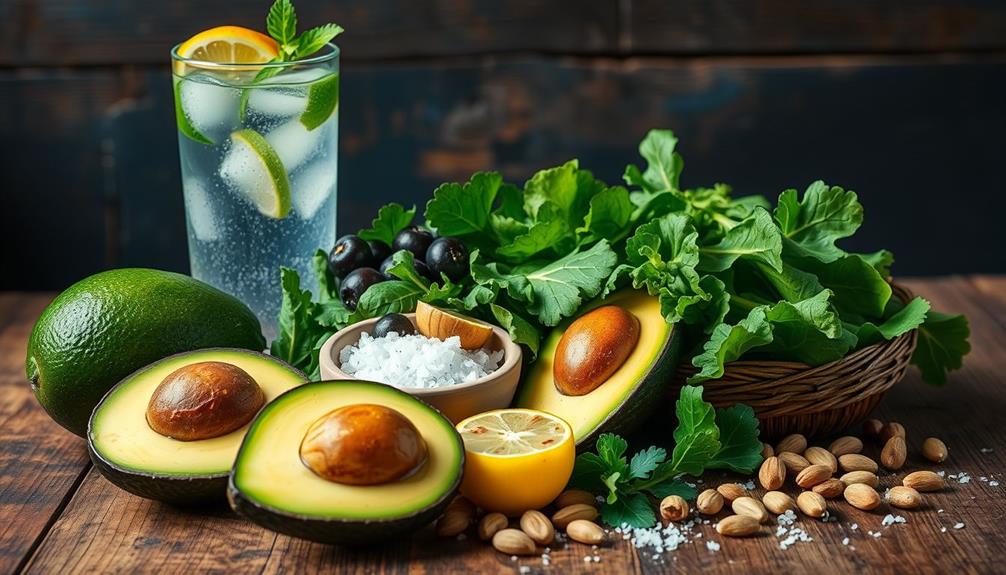
On a keto diet, your electrolyte needs change considerably, making it crucial to focus on key sources for sodium, potassium, magnesium, and calcium.
This is especially important because the ketogenic lifestyle can lead to increased water loss, which may deplete your body's electrolyte levels.
Incorporating a balanced diet rich in fruits, vegetables, and whole grains can also aid in maintaining these essential nutrients.
Since low-carb eating can lead to electrolyte loss, tracking your levels through regular blood tests helps guarantee you're getting what you need.
Understanding the importance of these electrolytes will support your overall health and keep you feeling your best on this diet.
Importance of Electrolytes
Your body's need for electrolytes becomes especially important when you're following a keto diet. As you lower your carb intake, your sodium levels can drop considerably, requiring you to aim for 2,000 to 4,000 mg of sodium daily to maintain balance.
Low insulin on a keto diet leads to increased sodium and potassium loss through urine, making it essential to monitor your electrolyte intake. Cold medications overview can also play a role in how your body handles electrolytes, as some may lead to dehydration. Without proper replenishment, you might experience symptoms of deficiency, which may include fatigue and muscle cramps.
Potassium levels are particularly challenging to maintain since potassium-rich foods are often high in carbs. Aim for a daily intake of 3,000 to 4,700 mg, and consider incorporating low-carb options to help meet this goal.
You also want to pay attention to magnesium deficiency, as this electrolyte plays a critical role in muscle function and reducing cramps. Green vegetables and nuts can help you source magnesium and calcium, essential for overall electrolyte balance.
Key Electrolyte Sources
Maintaining proper electrolyte levels while following a keto diet requires attention to specific food sources. For your sodium intake, aim for 2,000-4,000 mg daily to prevent dehydration and maintain fluid balance. Incorporate sources like salt, bone broth, and pickles into your meals.
Additionally, understanding your financial health can help you budget for these significant foods. Potassium-rich foods are important, too; regularly include avocados, spinach, and leafy greens to meet the recommended 3,000-4,700 mg per day. These foods support muscle function and help combat electrolyte loss.
Don't overlook magnesium, which is necessary for over 300 enzymatic processes in your body. Aim for about 400 mg daily by consuming nuts, seeds, and dark chocolate.
Additionally, calcium plays a key role in bone health and muscle function, so include dairy products or fortified foods in your diet, keeping an eye on normal calcium levels ranging from 8.8 to 10.7 mg/dl.
Monitoring Electrolyte Levels
Monitoring electrolyte levels is essential for anyone on a keto diet, as the shift to lower carbohydrate intake can lead to increased loss of sodium and potassium through urine. This can result in deficiencies that affect your overall health. To maintain fluid balance and prevent dehydration, you should aim for a sodium intake of 2,000 to 4,000 mg daily.
Regular blood tests are important for tracking potassium levels, which should remain between 3.6 to 5.5 mmol/L. Additionally, your magnesium status should fall within the range of 1.46 to 2.68 mg/dl, as magnesium is critical for numerous enzymatic processes that could be compromised on a low-carb diet.
Using apps like Carb Manager can help you monitor your daily electrolytes effectively. Here's a quick reference table to guide you:
| Electrolyte | Recommended Range |
|---|---|
| Sodium | 2,000 – 4,000 mg |
| Potassium | 3.6 – 5.5 mmol/L |
| Magnesium | 1.46 – 2.68 mg/dl |
Symptoms of Electrolyte Deficiencies

When you start a keto diet, you might notice some unsettling symptoms that could signal electrolyte deficiencies.
Common signs like fatigue, headaches, and muscle cramps can seriously impact your overall health.
These issues may arise due to the body's shift in water and sodium balance during the diet, making it vital to monitor your electrolytes closely.
Staying aware of these symptoms is essential for making the necessary dietary adjustments, especially considering the importance of energy-efficient models that can reduce heating and cooling costs by up to 50%.
Common Deficiency Symptoms
Electrolyte deficiencies can sneak up on you, especially during the early stages of a keto diet. As your body adapts, you might experience a range of symptoms that signal you're running low on essential minerals.
It's important to be aware of the potential effects, as discussed in mammography guidelines regarding early detection of health issues. Here are three common deficiency symptoms to watch for:
- Sodium Deficiency: This can lead to fatigue, headaches, and irritability. You may notice these symptoms more prominently as your body loses sodium through increased urination.
- Potassium Deficiency: If you're facing muscle cramps or heart palpitations, it could be a sign of potassium deficiency. This mineral is critical for muscle function and cardiovascular health.
- Magnesium Deficiency: Symptoms like muscle cramps, anxiety, and confusion indicate a lack of magnesium. This mineral supports over 300 enzymatic systems in your body, making it fundamental for overall health.
Recognizing these electrolyte deficiencies early is necessary for maintaining your well-being on the ketogenic diet.
Keep an eye on how you're feeling, and make sure to replenish your electrolytes to prevent complications.
Impact on Health
During the shift to a keto diet, you may notice various health impacts stemming from electrolyte deficiencies. Common symptoms include headaches, fatigue, and irritability, especially if you're experiencing low sodium levels.
It's important to incorporate yoga practices for relaxation to help manage stress and promote overall well-being. If you're not careful with your potassium intake, muscle cramps and heart palpitations might also arise, signaling a potassium deficiency.
Magnesium deficiency can worsen your situation, leading to anxiety, confusion, and further muscle cramping. Many people fail to meet the recommended daily intake of about 400 mg, which makes it vital to monitor your electrolyte minerals closely.
Calcium deficiency is another concern; it can affect your bone health and muscle function, resulting in weakness and an increased risk of fractures.
You may also encounter persistent symptoms of keto flu, like dizziness and gastrointestinal issues, highlighting the need for increased electrolyte intake.
To maintain your health on a keto diet, stay vigilant about your electrolytes. Regularly check in on your sodium, potassium, magnesium, and calcium levels, ensuring you're consuming enough to avoid these uncomfortable symptoms and support your overall well-being.
Top Food Sources for Electrolytes
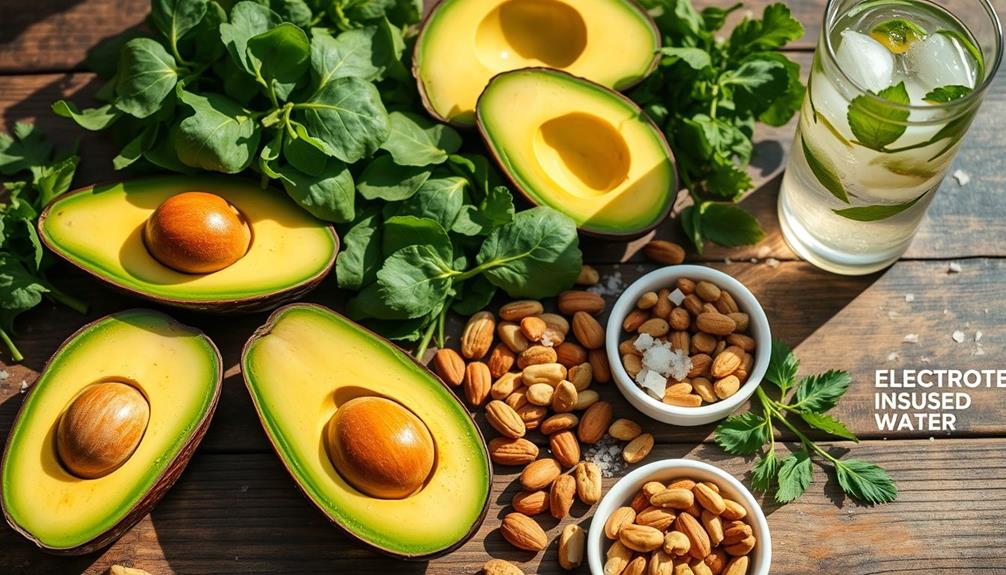
Maintaining proper electrolyte balance on a keto diet is essential for your overall health and well-being. You can easily incorporate foods rich in sodium, potassium, and magnesium into your meals to support this balance.
Additionally, using essential oils like peppermint oil can provide invigorating benefits that may enhance your overall wellness while on a keto diet.
Here are the top food sources for electrolytes:
- Leafy Greens: Spinach, kale, and romaine lettuce are excellent choices. They're packed with potassium, magnesium, and calcium, making them crucial for your electrolyte intake.
- Avocados: These creamy fruits aren't just delicious; they're high in potassium and magnesium. A medium avocado offers about 975 mg of potassium, making it a perfect low-carb option for replenishing your electrolytes.
- Fatty Fish: Salmon, sardines, and mackerel aren't just great sources of healthy fats and protein; they also provide significant amounts of potassium, magnesium, and sodium. Including these in your diet can greatly aid in restoring your electrolyte levels.
Don't forget nuts and seeds like almonds and pumpkin seeds, which also contribute to your magnesium and potassium intake.
Including these foods will help you maintain a balanced electrolyte profile while enjoying your keto journey.
Importance of Hydration
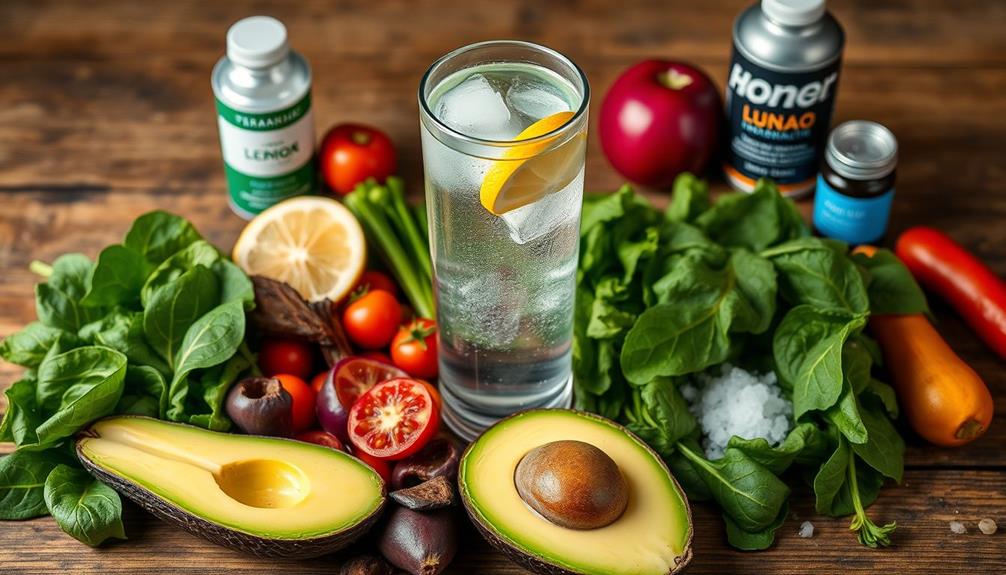
Hydration is a cornerstone of health, especially on a keto diet where lower carbohydrate intake can lead to increased fluid loss. When you reduce carbs, your insulin levels drop, causing your body to excrete more sodium and potassium, which can heighten your risk of dehydration.
Understanding the importance of maintaining electrolyte balance is essential, as it can help prevent symptoms of keto flu like headaches, fatigue, and muscle cramps.
Financial considerations for elderly care also emphasize the significance of hydration in maintaining overall health.
To support your hydration needs, aim to drink at least 2-3 liters of water daily. Adjust this based on your activity levels and climate. You can also incorporate electrolyte-rich fluids, such as bone broth or sugar-free electrolyte drinks, to enhance hydration and replenish essential minerals lost during the keto adaptation phase.
Regularly monitoring your hydration status is essential. If you notice signs of dehydration, increase your fluid intake.
Supplements for Electrolyte Balance
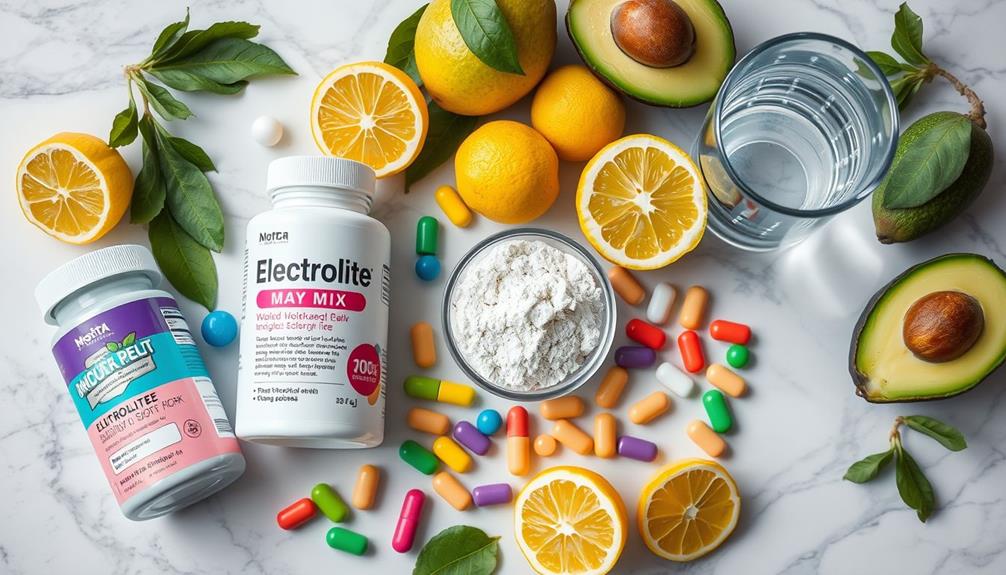
While you're adapting to the keto diet, incorporating supplements for electrolyte balance can be vital for your overall well-being.
With the lower sodium intake and potential deficiencies in magnesium and potassium, you might want to take into account electrolyte supplements to support your health, especially if you're exercising regularly.
Additionally, understanding the risks and rewards of Bitcoin IRAs can help you make informed financial decisions as you navigate dietary changes.
Here are three popular options:
- LMNT Electrolyte Packets: These provide a convenient way to replenish electrolytes without added sugars, making them perfect for low-carb or keto lifestyles.
- High 5 Zero Tablets: Another great low-carb option, these tablets dissolve easily in water, offering a rejuvenating way to boost your electrolyte levels.
- Potassium Supplements: If your dietary intake consistently falls short of the recommended 3,000-4,700 mg/day, potassium supplementation might be necessary.
Before starting any new supplements, it's important to consult a healthcare provider to guarantee they're safe for you.
Monitoring symptoms like muscle cramps, fatigue, and headaches can also help determine if you need more electrolytes.
Monitoring Your Electrolyte Levels
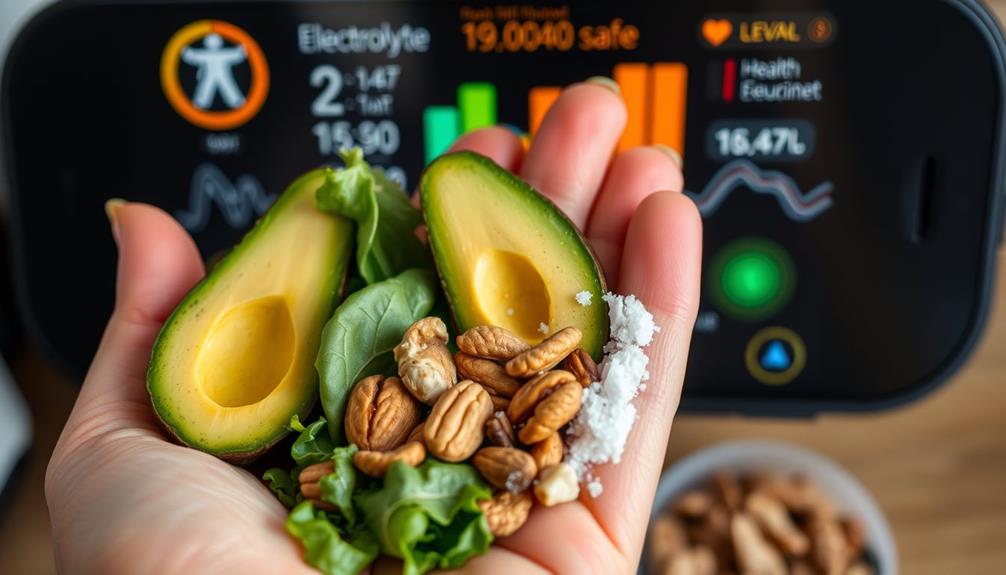
Monitoring your electrolyte levels is essential for staying healthy on the keto diet. Regular blood tests are recommended, particularly for potassium, as deficiencies can lead to serious symptoms like muscle cramps and heart palpitations.
You should also utilize dietary tracking apps, such as Carb Manager, to assess your sodium, potassium, magnesium, and calcium intake. This helps guarantee you meet the recommended levels for a low-carb diet.
Be vigilant about common symptoms of electrolyte deficiencies, including fatigue, headaches, and muscle cramps—these could signal the need for increased electrolyte intake. Aim for a sodium intake of 2,000-4,000 mg daily to maintain fluid balance and prevent dehydration.
It's wise to consult a healthcare professional before making any significant changes to your sodium intake.
Additionally, keep a hydration tracker to monitor your fluid consumption. Overhydration can dilute your blood sodium levels, potentially worsening any existing deficiencies.
Tips for Preventing Deficiencies

To keep your electrolyte levels balanced on the keto diet, it's important to take proactive steps to avert deficiencies. Focusing on your sodium, potassium, and magnesium intake will help you avoid issues like muscle cramps and fatigue.
Here are three essential tips:
- Increase Sodium Intake: Aim for 2,000-4,000 mg of sodium daily. Add salt to your meals and enjoy broth to boost your levels, especially during the initial stages of keto.
- Incorporate Potassium-Rich Foods: Include foods like avocados, spinach, and nuts in your diet. Target a daily intake of 3,000-4,700 mg to counterbalance the lower-carb options that limit potassium sources.
- Enhance Magnesium Levels: Focus on foods such as pumpkin seeds, dark chocolate, and leafy greens to reach a magnesium intake of about 400 mg daily. This helps prevent deficiencies that can lead to muscle cramps.
Don't forget to stay hydrated and consider electrolyte supplements, especially in the first few weeks.
Regularly monitor your dietary intake using tracking apps to guarantee you're meeting these essential daily intake levels.
Practical Meal Ideas for Keto

Eating well on a keto diet doesn't have to be complicated; you can easily create delicious meals that keep your electrolytes balanced. Start by incorporating leafy greens like spinach, kale, and broccoli into salads or smoothies. These whole foods are good sources of potassium and magnesium, helping you stay on track with your low-carb goals.
Don't forget about avocados! They're high in potassium and magnesium and make a creamy substitute for higher-carb fruits.
For protein, enjoy fatty fish such as salmon or mackerel. These options not only provide essential electrolytes but also deliver healthy omega-3 fatty acids.
Consider using bone broth as a base for soups or stews; it's rich in sodium and other key electrolytes while remaining low in carbohydrates.
If you're looking for snacks, grab a handful of nuts and seeds like almonds, pumpkin seeds, or macadamia nuts. They're excellent sources of magnesium and healthy fats, making them perfect for your keto diet.
Lastly, indulge in a bit of dark chocolate—just make sure it's low in sugar to maintain keto compliance!
Frequently Asked Questions
How to Replenish Electrolytes on a Keto Diet?
To replenish electrolytes, add salt to your meals, consume potassium-rich foods like avocados, and snack on magnesium-packed nuts. Stay hydrated with water or zero-carb drinks, and track your intake to guarantee balance.
What Are Good Electrolytes for Keto?
Good electrolytes for keto include sodium, potassium, magnesium, and calcium. You'll find sodium in salt, potassium in avocados, magnesium in nuts, and calcium in dairy. These nutrients support hydration, muscle function, and overall health.
How Do You Know if You Have Low Electrolytes on Keto?
Like a car sputtering on empty, you'll feel fatigue, headaches, and muscle cramps if you've got low electrolytes. Keep an eye out for irritability or heart palpitations, as those are key warning signs too.
Is Gatorade an Electrolyte for Keto?
Gatorade isn't ideal for your keto diet due to its high sugar content. Instead, opt for zero-sugar electrolyte drinks or supplements that help replenish your electrolytes without pushing you over your carb limits.
Conclusion
In your keto journey, keeping your electrolytes in check is like ensuring a well-tuned orchestra. By listening to your body's cues and incorporating delicious, nutrient-rich foods, you can dance around deficiencies with grace. Remember, hydration's your trusty sidekick, and a sprinkle of supplements can help fill any gaps. So, embrace these tips and savor the vibrant flavors of your meals, ensuring you stay energized and harmonious on this flavorful path to wellness.
